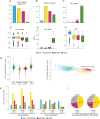Analysis of histone modification interplay reveals two distinct domains in facultative heterochromatin in Pyricularia oryzae
- PMID: 40695975
- PMCID: PMC12284244
- DOI: 10.1038/s42003-025-08473-2
Analysis of histone modification interplay reveals two distinct domains in facultative heterochromatin in Pyricularia oryzae
Abstract
Histone post-translational modifications (PTMs) interact in complex ways to regulate chromatin structure and gene expression. To investigate this interplay, we analyze ChIP-seq and RNA-seq data from knock-out mutants lacking enzymes responsible for H3K4me2/3, H3K9me3, or H3K27me3 in the phytopathogenic fungus Pyricularia oryzae. Loss of specific PTMs alters other PTMs and gene expression in a compartment-specific manner, with distinct effects across H3K4me2-rich euchromatin (EC), H3K27me3-rich facultative heterochromatin (fHC), H3K9me3-rich constitutive heterochromatin (cHC), and centromeres. We identify two distinct fHC subcompartments: K4-fHC, adjacent to EC, and K9-fHC, adjacent to cHC. Both contain poorly conserved genes, but K9-fHC harbors more transposable elements, while K4-fHC is more enriched for genes upregulated during infection, including effector-like genes. H3K27me3 levels in K4-fHC respond to changes in other PTMs, especially H3K9me3, and to environmental conditions. These findings suggest that K4-fHC functions as a reservoir of genes highly responsive to chromatin context and environmental cues.
© 2025. The Author(s).
Conflict of interest statement
Competing interests: The authors declare no competing interests.
Figures








Similar articles
-
Senescence-associated alterations in histone H3 modifications, HP1 alpha levels and distribution, and in the transcriptome of vascular smooth muscle cells in different types of senescence.Cell Commun Signal. 2025 Jul 1;23(1):321. doi: 10.1186/s12964-025-02315-8. Cell Commun Signal. 2025. PMID: 40597225 Free PMC article.
-
Bath: a Bayesian approach to analyze epigenetic transitions reveals a dual role of H3K27me3 in chondrogenesis.Epigenetics Chromatin. 2025 Jun 27;18(1):38. doi: 10.1186/s13072-025-00594-6. Epigenetics Chromatin. 2025. PMID: 40571950 Free PMC article.
-
A mutant ASXL1-BAP1-EHMT complex contributes to heterochromatin dysfunction in clonal hematopoiesis and chronic monomyelocytic leukemia.Proc Natl Acad Sci U S A. 2025 Jan 7;122(1):e2413302121. doi: 10.1073/pnas.2413302121. Epub 2025 Jan 3. Proc Natl Acad Sci U S A. 2025. PMID: 39752521 Free PMC article.
-
Modulating Cognition-Linked Histone Acetyltransferases (HATs) as a Therapeutic Strategy for Neurodegenerative Diseases: Recent Advances and Future Trends.Cells. 2025 Jun 10;14(12):873. doi: 10.3390/cells14120873. Cells. 2025. PMID: 40558500 Free PMC article. Review.
-
Euchromatin and Heterochromatin: Implications for DNA Accessibility and Transcription.J Mol Biol. 2025 Jun 6:169270. doi: 10.1016/j.jmb.2025.169270. Online ahead of print. J Mol Biol. 2025. PMID: 40482957 Review.
References
-
- Fischle, W., Wang, Y. & Allis, C. D. Histone and chromatin cross-talk. Curr. Opin. Cell Biol.15, 172–183 (2003). - PubMed
MeSH terms
Substances
Supplementary concepts
Grants and funding
LinkOut - more resources
Full Text Sources
Miscellaneous

